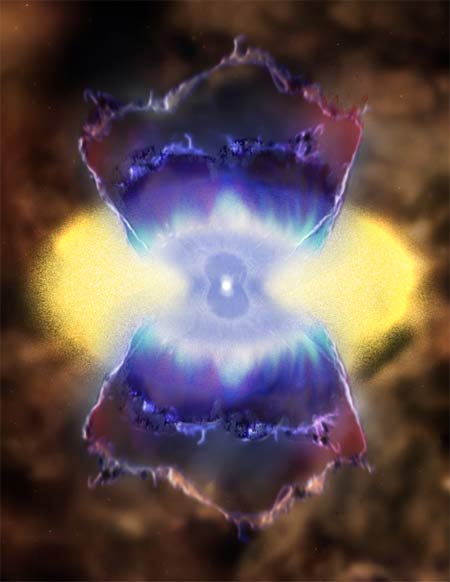Key Found to Birth of Super-Galaxies

Astronomershave spotted what they think is evidence for the ignition switch that turns onsuper-bright galaxies called quasars.
The triggerwas likely the merger of two galaxies, researchers said today.
Quasarswere first detected in the 1950s based on emissions of radio waves. Astronomersthought they were strange nearby stars. Later they figured out the brilliantbeacons were billions of light-years away.
That's howthey got the name quasar, which is short for quasi-stellar radio sources.
A frenzy
A quasar isin fact a large galaxy anchored by a supermassive black hole that isactively--very actively-- feeding on surrounding gas. The frenzy causes the gasto heat up and glow so brightly that it outshines the galaxy itself.
Get the Space.com Newsletter
Breaking space news, the latest updates on rocket launches, skywatching events and more!
How quasarsare born has remained a mystery.
NASA's Chandra X-ray Observatory detected hot, X-ray regionsaround two distantquasars. Each feature is tens of thousands of light-years from the central supermassiveblack hole thought to power the quasar.
"The X-ray features are likely shock waves that could bea direct result of the turning on of the quasar about 4 billion yearsago," said Alan Stockton of the University of Hawaii in Honolulu, and leadauthor of a report on the findings in the Astrophysical Journal.
The quasars, 4C37.43and 3C249.1, do not appear to be surrounded by any larger gas envelopes, andthe X-ray regions were not associated with radio waves from the quasars.
"The best explanation for our observations is that aburst of star formation, or the activation of the quasar itself, is driving anenormous amount of gas away from the quasar's host galaxy at extremely highspeeds," said co-author Hai Fu, also from the University of Hawaii.
A merger
Computer simulations led by Tiziana Di Matteo ofCarnegie-Mellon University in Pittsburgh, Pennsylvania suggest a specificmechanism that might have triggered the activity: The merger of two galaxiesdrives gas toward the central regions where it triggers a burst of starformation and provides fuel for the black hole.
The inflow of gas releases a tremendous amount of energy,and a quasar is born.
The quasar's output dwarfs the rest of the galaxy andgenerates a superwindthat drives material into intergalactic space. The Chandra data provide thebest evidence yet for a quasar-produced superwind, the researchers conclude.
After about 100 million years in this scenario, the superwindwill drive all the gas out. The quasar phase will end and the galaxy willsettle down to a relatively quiet life, more like the situation in our own Milky Way.
Twinkle,Twinkle, Little Quasar
HiddenBlack Holes Found Behind Gas Veils at Quasars
QuasarJets Create Cosmic Pileups
Join our Space Forums to keep talking space on the latest missions, night sky and more! And if you have a news tip, correction or comment, let us know at: community@space.com.

Rob has been producing internet content since the mid-1990s. He was a writer, editor and Director of Site Operations at Space.com starting in 1999. He served as Managing Editor of LiveScience since its launch in 2004. He then oversaw news operations for the Space.com's then-parent company TechMediaNetwork's growing suite of technology, science and business news sites. Prior to joining the company, Rob was an editor at The Star-Ledger in New Jersey. He has a journalism degree from Humboldt State University in California, is an author and also writes for Medium.









